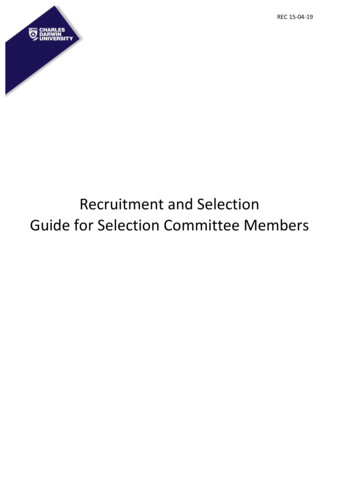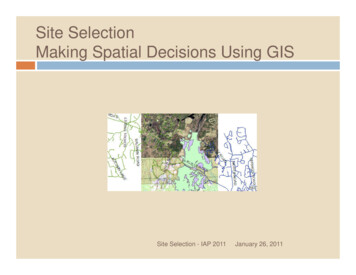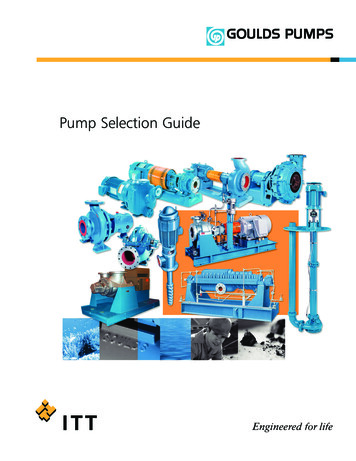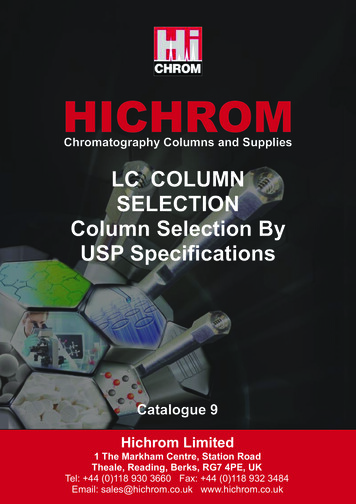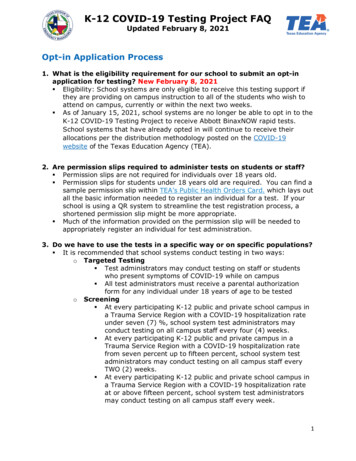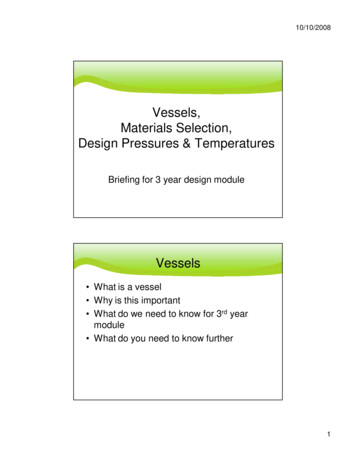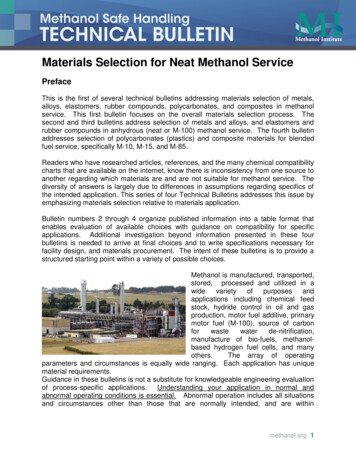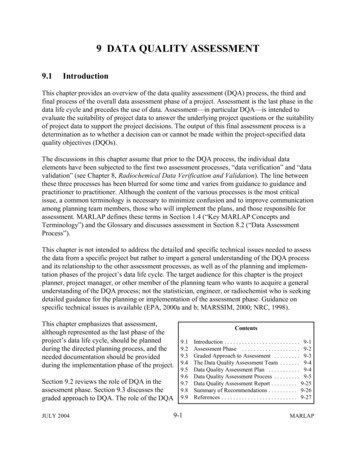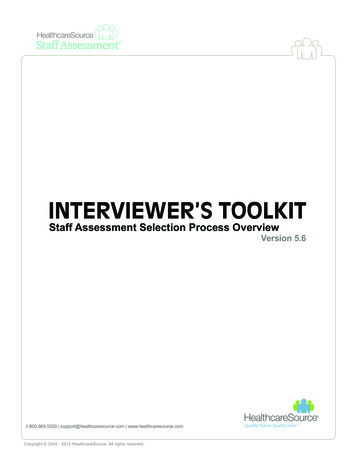
Transcription
Staff Assessment Selection Process OverviewVersion 5.61.800.869.5200 support@healthcaresource.com www.healthcaresource.comCopyright 2004 - 2012 HealthcareSource. All rights reserved.
Limited LicenseThe Staff Assessment Interviewer’s Toolkit and other products and tools created byHealthcareSource are intended solely for internal use by parties who are current clients/customersof HealthcareSource, and may be copied and/or distributed internally so long as such parties arecurrent clients/customers of HealthcareSource.Such parties agree to return or destroy all products and/or tools and copies thereof shouldtermination of the client/customer relationship with HealthcareSource occur. Further, any individualleaving the organization is prohibited from accessing, copying or utilizing these materials.Subject to this Limited License, HealthcareSource expressly retains ownership of all rights in theStaff Assessment Interviewer’s Toolkit, including, but not limited to, the right to make derivative worksthereof.In the event a recipient of any HealthcareSource products and/or tools or copies thereof disagreeswith any of the terms of this Limited License, such recipient agrees to immediately return all suchproducts and/or tools and any copies thereof to HealthcareSource.1.800.869.5200 support@healthcaresource.com www.healthcaresource.comCopyright 2004 - 2012 HealthcareSource. All rights reserved.page 2
Staff Assessment Selection ProcessSMHealthcareSource Staff AssessmentSMThe HealthcareSource Staff Assessment was designed and validated specifically to assist hospitalsand other healthcare organizations select and promote individuals who are most likely to be successfulin that environment. The purpose of the Staff Assessment is to provide the individuals responsible forstaffing with a complete selection system. As such, the Staff Assessment provides six distinct types ofinformation:1. “Confidence-In-Results” Scale2. “Inflated Response” Scale3. Job Fit Indices4. Service & Values Scales5. Job Preview Matrix6. Structured Interview GuideEach of the six components is described briefly below. Before discussing each of the six components,you should know that the Staff Assessment is really five different instruments, not just one. The StaffAssessment was developed and validated for five distinct Job Groups or Families. As such, separatescoring keys, group norms, and interview questions have been developed for each of five different JobFamilies:Job FamilyNursingPatient CareAdministrative/ClericalEntry-level ServiceProfessional & TechnicalJobs IncludeRN, LPN, Nurse PractitionerCNA/NA/STNA, Home Health Aide, Medical Assistant, PhlebotomistAdministrative Assistant, Billing Specialist, Data Entry, File Clerk,Medical Transcriptionist, Patient Registration, etc.Environmental Services, Dietary, Patient Transport, Greeter, Security,etc.Cardiac Sonographer, Cath Lab Rad Tech, EEG Tech, Lab Tech,Occupational Therapist, Pharmacy Tech, Radiology Technologist,Respiratory Therapist, etc.When administering the Staff Assessment, make sure that all applicants for a particular position areplaced in the correct Job Family so that results are directly comparable.Copyright 2004 - 2012 HealthcareSource. All rights reserved.page 3
The Staff Assessment Selection Process1. “Confidence-In-Results” ScaleThis scale provides test administrators with an index of the applicant’s assessment validity. The score on thisscale indicates the degree to which the applicant’s personality profile can be trusted as being consistent andinterpretable. Typically, a caution score on this scale means that the applicant either had trouble reading andinterpreting item content OR he/she was not paying attention to the instrument and was randomly answeringthe items.Exhibit 1“Confidence-In-Results” Scale“CONFIDENCE-IN-RESULTS” SCALEOKCAUTIONThis applicant responded to questions in a consistentmanner. It appears they were paying attention and able toread the survey.2. “Inflated Response” ScaleThis scale provides test administrators with an index of social desirability responses. Typically, a cautionscore on this scale means that the applicant is either trying to make a very favorable impression on hiringdecision-makers or the applicant has an unrealistic positive view of self.Exhibit 2“Inflated Response” Scale“Inflated Response” SCALEOKCAUTIONThis applicant responded to questions in a forthright,realistic manner.Copyright 2004 - 2012 HealthcareSource. All rights reserved.page 4
The Staff Assessment Selection Process3. Job Fit IndicesThe Job Fit Indices give an overall view of the applicant’s potential for success. Three scales are used toprovide this overall picture of likely job performance:1. Job Performance Index2. Retention Index3. Service Excellence IndexExhibit 3 shows an example of what this feedback might look like for a particular applicant.Exhibit 3Job Fit IndicesJOB FIT INDICES - NursingWhen scores are in the 1-2 range the applicantshould be pursued with a considerable degree ofcaution (providing the index is relevant).LOW12AVERAGE3456HIGH78910JOB PERFORMANCE INDEXThe higher an individual scores on this index,the more likely they are to be rated as a“top performer” within this Job Family.RETENTION INDEXThe higher an individual scores on this index,the more likely they are to be committed to theorganization, and, less likely than theircoworkers to leave the organization.SERVICE EXCELLENCE INDEXThe higher an individual scores on this index,the more likely they are to be rated as a “topservice provider” within this Job Family.Generally speaking, when scale scores are in the 1-2 range, the applicant should be viewed witha considerable degree of skepticism or caution. Some organizations may choose to automaticallyreject applicants that score in the “low” range for one or more of the three indices. If you do decide toautomatically reject applicants with scores of 2 or lower, make sure that the “Service Excellence” indexis job related. For example, jobs with little or no patient or client contact (e.g. food preparation, laundry)may not require a high score on Service Excellence. If the applicant will likely perform well (i.e., OverallPerformance Index) and stay with the organization (i.e., Retention Index), then a low score on ServiceExcellence may be acceptable for certain jobs.Copyright 2004 - 2012 HealthcareSource. All rights reserved.page 5
The Staff Assessment Selection ProcessApplicants with scores ranging from 3 to 8 are considered “average” or acceptable, and scale scores ofnine and above are considered “high.” For example, the Job Fit scores shown in Exhibit 3 indicate thatthe applicant will likely be good performer. The likelihood of their leaving the organization is somewhathigh, and, they are in the 5th percentile in terms of their Customer Service attributes as compared to otherNurses.4. Service and Values ScalesThe Staff Assessment measures nine critical service and values performance factors determined to beimportant in healthcare organizations.These nine scales have been identified as important factors contributing to successful job performance. Scoresin the “low” range (scores 1-2.5) indicate a POTENTIAL problem area. Custom-written interview questions areprovided in the Feedback Report to determine if the applicant’s “fit” is in alignment with job and organizationalrequirements.Exhibit 4Service and Values FactorsSERVICE & VALUES SCALESThe following scales and service attributes have been identified as important factors contributing to successful job performance.Scores in the “low” range (score 1-2.5) indicate a POTENTIAL problem area. Custom-written interview questions are provided todetermine if the applicant’s “fit” is in alignment with job and organizational requirements.LOW SCORESLOW12AVERAGE3456HIGH789HIGH SCORES10WORK ETHIC/ATTENDANCELacks ambition,requires direction,poor attendance.Self motivated,believes in hardwork and goodattendance.ENERGYSlow work pace,minimal work effort.Helps others andseeks additionalwork.TEAMWORKAvoids teamsettings. Frequentconflicts with others.Use custom questionsto probe this scale.Team oriented.Works with othersto achieve goals.CUSTOMER FOCUSIgnores or avoidsrequest for service.Sees customers asan imposition.Use custom questionsto probe this scale.Responds toneeds of others.Satisfies patientsand families.Conscientious, hard working anddependable.Maintains a high level of activity.Works closely with others andreinforces the contributions of others.Warm friendly demeanor. Enjoyspersonal contact with customers.Genuine desire to help and assistothers.Cold and distant.Impatient.Genuine concernfor patients.Sympathetic andpatient.FLEXIBILITY/ADAPTABILITYResists change.Complains whenasked to adjustpriorities.Quickly adjusts tochange. Flexibleto changes inpriorities anddemands.MULTI-TASKINGFrustrated bymultiple demands.Focuses on onething at a time.Easily managemultiple demandsand activities.VALUING DIVERSITYIntolerant/critical ofothers. Has difficultywith others that are“different.”Relates well withothers different fromself (varied race,gender, age, etc).OPENNESS TO LEARNINGAvoids trainingopportunities.Resists newmethods.Embraces training.Updates skills onown.COMPASSIONAbility to adjust to changes inpriorities, demands and procedures.Ability to manage multiple taskssimultaneously.Accepts and embraces differencesamong people.Willingness to update and improvejob related skills and knowledge.Copyright 2004 - 2012 HealthcareSource. All rights reserved.page 6
The Staff Assessment Selection ProcessThe feedback example shown in Exhibit 4 provides scores on each of the nine service and valuesfactors. As shown, scores for both Teamwork and Customer Focus are in the “low” range and indicatepotential problem areas. Custom-written interview questions are provided to follow-up and determine ifthe applicant’s “fit” is in alignment with job and organizational requirements. This example shows that theapplicant scored “high” in a number of other areas. The key to interpreting this portion of the feedback is tocarefully examine the importance of each of the nine scales for the target job or position.5. Job Preview MatrixThis component provides feedback on how well the interests of the applicant match with the workdemands of the typical healthcare environment. Issues such as being on-call, working unconventionalschedules, and being around sick individuals are examined. Exhibit 5 shows an example of what JobPreview feedback might look like for a particular applicant.Exhibit 5Job Preview MatrixJOB PREVIEW MATRIXReview the job requirements. Probe requirements where anapplicant has expressed “reluctance” or “refusal.” Refer tothe Staff Assessment Interviewer’s Toolkit for specific followup questions.Work on-call (available to work as needed)Work around people with contagious diseasesWork on holidaysWork evenings (2nd shift)Work nights (3rd shift)Work a 12-hour shiftWork weekendsDeal with body fluids and bloodREFUSAL RELUCTANTI will not:Rather not:WILLINGNOT 1stChoice:Doesn’tMake aDifference:XXXXXXXXInterviewers should carefully review the requirements of the job and then probe the applicant regardingany tasks where an applicant has expressed “refusal” or “reluctance.” If, for example, the results in Exhibit6 were obtained from a applicant, then the interviewers should follow-up with questions regarding “workingon-call”, “working holidays”, and “working weekends.” If the requirement is not part of the job (e.g., theemployee does not have to work weekends), then probing on that requirement would not be necessary.Copyright 2004 - 2012 HealthcareSource. All rights reserved.page 7
The Staff Assessment Selection Process6. Structured Interview GuideThe Staff Assessment Feedback Report will provide you with a structured interview guide that containspre-developed interview questions and space to insert your own position-specific technical questions. Assuch, the Interview Guide is comprised of four sections:1. Job Preview follow-up questions2. Questions for Service and Values factors that are in the “low” range3. General questions that are tailored for each job family4. Space formatted to include position-specific technical questionsSection 1: Job preview follow-up questions.Selection research shows that interviewers should avoid sugar coating their descriptions of the job, andinstead, provide applicants with a realistic job preview (RJP). To avoid unfulfilled expectations and costlyturnover, interviewers should provide accurate communication regarding job requirements prior to thehiring decision. By providing an accurate description to applicants, the process of job choice is facilitated;those who accept employment will be more satisfied and thus be less likely to leave voluntarily.As previously discussed, the Staff Assessment assists the realistic preview process by asking eight RJPrelated questions (e.g., working on holidays, being “on-call”) and reporting applicant responses to thosequestions. In those situations where the applicant expresses “reluctance” or “refusal” to perform the jobrequirement (and the requirement is job related), the interviewer should follow-up with questions to assessthe applicant’s willingness to perform certain aspects of the job. Job Preview Questions containssample questions to aid in that assessment.Section 2: Service & Values custom questions for “low” scores.This section of the interview guide provides you with specific questions to probe areas of concern revealedfrom the Staff Assessment results (any of the nine scale scores in the “low” range). Use these questions tofollow-up and determine if the applicant’s “fit” is in alignment with job and organizational requirements. Theguide automatically provides a minimum of three pre-determined questions for any scale score in the “low”(1-2.5 score) range. But interviewers should feel free to:1. Use any or all of the questions and probes provided as is.2. Modify those questions to fit the job and circumstances.3. Use additional questions provided in Interview Questions by Competency.Interviewers should also feel free to use the questions provided in the Interview Questions by Competencyto probe areas that are important to the target job but that didn’t receive a score in the “low” range. Forexample, suppose that “Openness to Learning” is seen as a critical aspect of job performance but theapplicant scores at an acceptable level on the Staff Assessment. Interviewers may still think that the factoris important enough to ask a couple of interview questions assessing that important factor.Copyright 2004 - 2012 HealthcareSource. All rights reserved.page 8
The Staff Assessment Selection ProcessSection 3: General questions.This section of the Structured Interview Guide provides questions and probes targeted for the five JobFamilies previously discussed (i.e., Nursing, Patient Care, Entry-Level Service, Administrative/Clerical,and Technical/ Professional). Interviewers should feel free to use any or all of the questions provided.Additional interview questions for each of the five families may be found in Peer Interview Guidesby Job Family.Section 4: Technical questions.While the Staff Assessment selection system is effective for assessing the general factors orcompetencies important for success in a particular job (the so-called “soft” skills), it makes no pretensefor measuring specific technical skills and knowledge (“hard” skills) important to job success. To developa bank of technical questions for the hundreds of separate job classifications in healthcare organizationswould be unrealistic. However, because assessing the applicant’s technical knowledge and skills is animportant component of the selection process, we have provided a section of the Interview Guide thatallows interviewers the opportunity to ask very technical or skill oriented questions related to the targetposition. This section provides a “sample technical question” and space for additional user-definedquestions.Note: Additional “sample” technical questions can also be found in Peer Interview Guides byJob Family. These sample questions are only intended to provide interviewers with enoughexamples to obtain a reasonable understanding of what a good technical question should looklike. They are not intended to be relevant for all jobs or comprehensive.Note: Individualized scoring keys and feedback reports have been developed for thefive specific Job Families previously mentioned (i.e., Nursing, Patient Care, Entry-LevelService, Administrative/Clerical, and Technical/Professional). Each Feedback Report has aspecific scoring formula tailored to one of the five Job Families. The tailoring of reports wasaccomplished by validating the Staff Assessment for each Job Family and developing separatescoring keys, norms, and interview questions that are reflective of that particular grouping ofjobs.Copyright 2004 - 2012 HealthcareSource. All rights reserved.page 9
6. Structured Interview Guide The Staff Assessment Feedback Report will provide you with a structured interview guide that contains pre-developed interview questions and space to insert your own position-specific technical questions. As such, the Interview guide is comprised of four sections: 1. Job preview follow-up questions 2.
